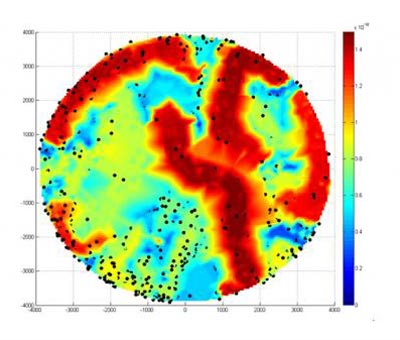A computational analysis identifies a new clinical phenotype of severe malaria

This density heatmap shows the distribution of patients in the 8-dimensional feature space. Higher density values (in red) indicate closer proximity of patients in this feature space. Black dots indicate SM patients who died. Credit: Cominetti O et al, Figure 2
There are more clinical phenotypes of severe malaria than those defined by the World Health Organization (WHO), according to a study led by ISGlobal, an institution supported by “la Caixa” Foundation. The results indicate that heart failure can be a pathogenic mechanism of disease, which has implications in the clinical management of these patients.
Despite the progress achieved over the last decades, malaria is estimated to have caused almost half a million deaths in 2016, mostly among children. The definition of severe malaria was established to identify those children at risk of dying, but in reality it is a complex and heterogeneous disease that not always responds to the recommended treatments.
The team led by Climent Casals-Pascual, researcher at ISGlobal and at Oxford University, applied a computational analysis based on networks in order to identify biologically relevant phenotypes apart from those currently defined by the WHO (cerebral malaria, respiratory distress, and severe malarial anaemia). For this, they performed a 'network-based clustering analysis' with data from almost 3,000 Gambian children hospitalized with malaria.
They found that the mortality was higher in those clusters with higher phenotypic heterogeneity. The analysis revealed four clusters of patients with both respiratory distress and severe anaemia, in which an increase in liver size was associated with higher mortality. By analysing plasma proteins of these patients, they showed that this is likely due to heart failure.
“Our results indicate that heart failure should be reconsidered as a pathogenic mechanism in severe malaria,” explains Casals-Pascual, “and that therefore the standard clinical management may not be appropriate for these patients”. This type of “systems approach” can be a very valuable tool to identify new phenotypes and mechanisms as well as therapeutic options for complex diseases”, he adds.
###
Reference
Cominetti O, Smith D, Hoffman F, et al. Identification of a novel clinical phenotype of severe malaria using a network-based clustering approach. Scientific Reports. 2018. 8:12849. DOI:10.1038/s41598-018-31320-w
Media Contact
All latest news from the category: Health and Medicine
This subject area encompasses research and studies in the field of human medicine.
Among the wide-ranging list of topics covered here are anesthesiology, anatomy, surgery, human genetics, hygiene and environmental medicine, internal medicine, neurology, pharmacology, physiology, urology and dental medicine.
Newest articles

Red light therapy for repairing spinal cord injury passes milestone
Patients with spinal cord injury (SCI) could benefit from a future treatment to repair nerve connections using red and near-infrared light. The method, invented by scientists at the University of…

Insect research is revolutionized by technology
New technologies can revolutionise insect research and environmental monitoring. By using DNA, images, sounds and flight patterns analysed by AI, it’s possible to gain new insights into the world of…

X-ray satellite XMM-newton sees ‘space clover’ in a new light
Astronomers have discovered enormous circular radio features of unknown origin around some galaxies. Now, new observations of one dubbed the Cloverleaf suggest it was created by clashing groups of galaxies….





















